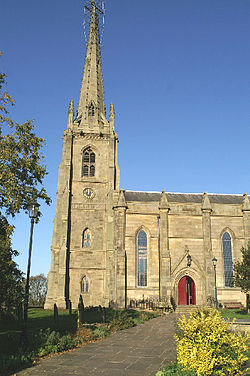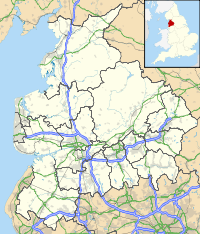- St Michael's Church, Kirkham
-
St Michael's Church, Kirkham 
St Michael's Church, Kirkham, from the southLocation in Lancashire Coordinates: 53°47′03″N 2°52′16″W / 53.7843°N 2.8710°W OS grid reference SD 427 323 Location Church Street, Kirkham, Lancashire Country England Denomination Anglican Website St Michael's, Kirkham History Dedication St Michael Architecture Status Parish church Functional status Active Heritage designation Grade II* Designated 20 September 1985 Architect(s) Robert Roper,
Edmund Sharpe,
Joseph Hansom (?)Architectural type Church Style Gothic Revival Groundbreaking 1822 Completed 1853 Construction cost £5,000 (nave)
(£370,000 as of 2011),[1]Specifications Capacity 600 Spire height 150 feet (46 m) Materials Ashlar sandstone, slate roofs Administration Parish Kirkham Deanery Kirkham Archdeaconry Lancaster Diocese Blackburn Province York Clergy Vicar(s) Rev Rick Bunday Assistant priest Rev Kevan Thorn Laity Reader Noreen Marshall,
Alan SawyerDirector of music Edward Rugman Churchwarden(s) Jane Cairns, Maralyn Nott St Michael's Church, Kirkham is in the town of Kirkham in the Fylde district of Lancashire, England. The church has been designated by English Heritage as a Grade II* listed building.[2] It is an active Anglican parish church in the diocese of Blackburn, the archdeaconry of Lancaster and the deanery of Kirkham.[3]
Contents
History
The earliest evidence of a church on the site is in 684 AD. The fabric of the present church dates from 1822 when the nave, designed by Robert Roper, an architect from Preston, was built.[4] The cost of the nave was £5,000 (£370,000 as of 2011).[1][5] In 1843–44 the steeple, designed by the Lancaster architect Edmund Sharpe, was added at the west end. The foundation stone for this was laid on 21 November 1843 by Thomas Clifton of Lytham Hall.[6] In 1853 the chancel was rebuilt, probably by Joseph Hansom, to make the altar visible from the nave.[2] The north and south galleries were removed in the middle of the 20th century and the area under the west gallery has been turned into a separate room.[4] In 2004 it was discovered that the spire had developed structural problems because the iron ties reinforcing the stones had corroded. An appeal to repair the spire was launched.[7]
Architecture
Exterior
The church is built in sandstone ashlar with slate roofs. Its plan consists of a six-bay nave without aisles, a three-bay chancel with aisles which are now used as vestries. To the north and south gabled porches project slightly from the second bays from west. The other bays have lancet windows between gabled buttresses. The nave is in Early English style and the chancel is in Decorated style.[2] The steeple is in Perpendicular style.[6] It has angle buttresses and is in four stages. The parapet is embattled and pinnacles rise from the corners. The octagonal spire is recessed and rises to a height of 150 feet (46 m). It is crocketed, has three tiers of two-light lucarnes and is supported by four flying buttresses.[2] The architectural historian Nikolaus Pevsner considers it to be possibly the finest work of Edmund Sharpe.[5]
Interior
The roof of the nave is painted red and is divided into squares by ribs, at whose intersections are gilded bosses of different designs. The font is located half way down the north side of the nave. It is Victorian and consists of an octagonal gabled and crocketted bowl on an octagonal column. The wooden pulpit is massive, measuring approximately 125 feet (38 m) from the base to the top.[4] To the east of the south door are churchwardens' box pews carved with Gothic details and poppyheads.[2] They bear a brass plate dated 1770 but Pevsner states they must be Victorian.[5] In the nave are monuments to the memory of the Cliftons of Lytham Hall, including one to Thomas Clifton who died in 1688. A wall tablet commemorates Richard Bradkirk of Bryning Hall who died in 1813[2] and another monument is to Henry Rishton Buck, a lieutenant aged 27 who died at the Battle of Waterloo.[4] Behind the altar is a folding reredos dated 1900 which was made by Kempe and moved from Christ Church Cathedral, Oxford.[4] The brass chandelier dated 1725 was made by Brown of Wigan. The communion plate includes a set dated 1845.[5] The organ dates back to 1769 when it was built by Glyn Parker of Salford. Later modifications were made by R. W. Nicholson of Bradford (at an unrecorded date), by Harrison & Harrison in 1905, and by the Pendlebury Organ Company of Cleveleys in 1979.[8] The ring consists of eight bells which were cast by Charles & George Mears at the Whitechapel Bell Foundry in 1846.[9]
External features
In the churchyard is a sundial made of sandstone dating probably from the 18th century with a 20th-century top. It consists of a fluted circular column without a base set into a circular slab and capped with a Tuscan capital which carries a round bronze dial and a gnomon. It is listed Grade II.[10] Also in the churchyard and listed Grade II are a tomb chest to Edward and Dorothy King dating from the early 19th century,[11] a tomb chest to Edward and Elizabeth Birley dating from around 1836,[12] and a monument in the style of a Gothic tabernacle to William Birley and others dating from the middle of the 19th century.[13]
Since the completion of the works to repair the spire, during the hours of darkness the church and spire have been floodlit.[citation needed]
See also
- List of architectural works by Edmund Sharpe
References
- ^ a b UK CPI inflation numbers based on data available from Lawrence H. Officer (2010) "What Were the UK Earnings and Prices Then?" MeasuringWorth.
- ^ a b c d e f "Church of St Michael, Kirkham", The National Heritage List for England (English Heritage), 2011, http://list.english-heritage.org.uk/resultsingle.aspx?uid=1362357, retrieved 17 May 2011
- ^ St Michael, Kirkham, Church of England, http://www.achurchnearyou.com/kirkham-st-michael/, retrieved 17 May 2011
- ^ a b c d e The Church Building, St Michael's, Kirkham, http://www.stmichaelskirkham.org.uk/thechurchbuilding.htm, retrieved 1 March 2008
- ^ a b c d Pevsner, Nikolaus (2002) [1969], North Lancashire, The Buildings of England, New Haven and London: Yale University Press, p. 150, ISBN 0-300-09617-8
- ^ a b Hughes, John M. (2010), Edmund Sharpe: Man of Lancaster, John M. Hughes, p. 209
- ^ The Spire, St Michael's, Kirkham, http://www.stmichaelskirkham.org.uk/thespire.htm, retrieved 1 March 2008
- ^ Kirkham St. Michael, British Institute of Organ Studies, http://www.npor.org.uk/cgi-bin/Rsearch.cgi?Fn=Rsearch&rec_index=N10907, retrieved 15 August 2008
- ^ Kirkham S Michael, Dove's Guide for Church Bell Ringers, http://dove.cccbr.org.uk/detail.php?searchString=Kirkham%2C+S+Michael&Submit=++Go++&DoveID=KIRKHAM, retrieved 15 August 2008
- ^ "Sundial in churchyard circa 20 metres south of the south porch of the Church of St Michael, Kirkham", The National Heritage List for England (English Heritage), 2011, http://list.english-heritage.org.uk/resultsingle.aspx?uid=1072022, retrieved 17 May 2011
- ^ "Tomb of Edward and Dorothy King in churchyard circa 50 metres south east of the porch of the Church of St Michael, Kirkham", The National Heritage List for England (English Heritage), 2011, http://list.english-heritage.org.uk/resultsingle.aspx?uid=1072023, retrieved 17 May 2011
- ^ "Tomb of Edward and Elizabeth Birley in churchyard circa 50 metres south east of the porch of the Church of St Michael, Kirkham", The National Heritage List for England (English Heritage), 2011, http://list.english-heritage.org.uk/resultsingle.aspx?uid=1163974, retrieved 17 May 2011
- ^ "Tomb of William Birley and others in churchyard circa 50 metres south east of the porch of the Church of St Michael, Kirkham", The National Heritage List for England (English Heritage), 2011, http://list.english-heritage.org.uk/resultsingle.aspx?uid=1362358, retrieved 17 May 2011
External links
 Media related to St Michael's Church, Kirkham at Wikimedia Commons
Media related to St Michael's Church, Kirkham at Wikimedia Commons
Categories:- Church of England churches in Lancashire
- Grade II* listed buildings in Lancashire
- Grade II* listed churches
- Gothic Revival architecture in England
- Religious buildings completed in 1822
- 1844 architecture
- Religious buildings completed in 1853
- 19th-century Church of England church buildings
- Edmund Sharpe buildings
- Diocese of Blackburn
- Buildings and structures in Fylde (borough)
Wikimedia Foundation. 2010.

